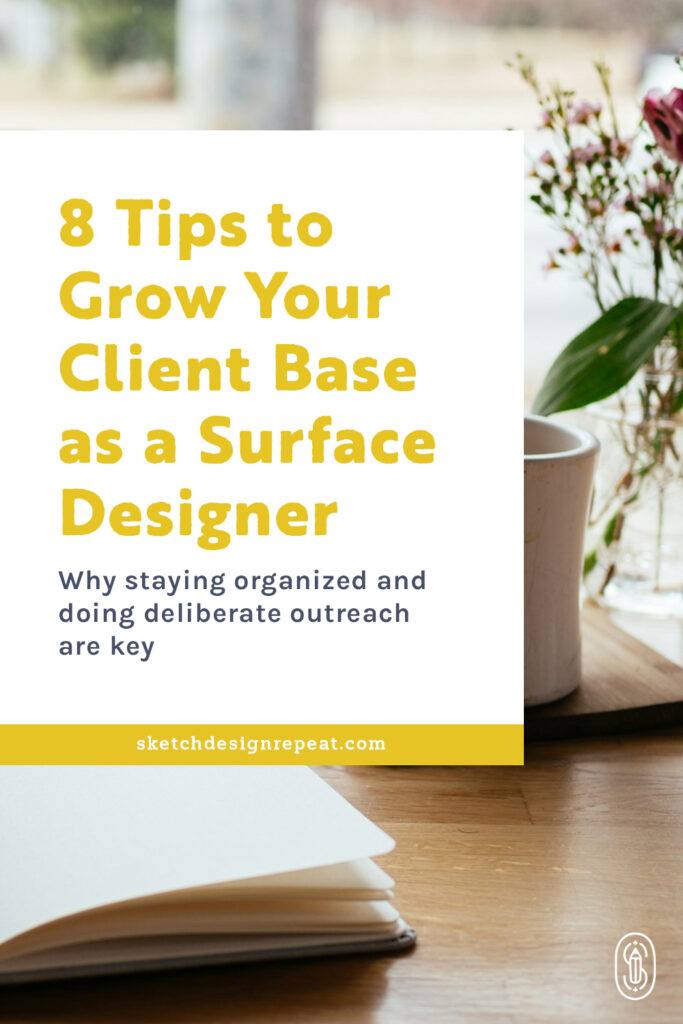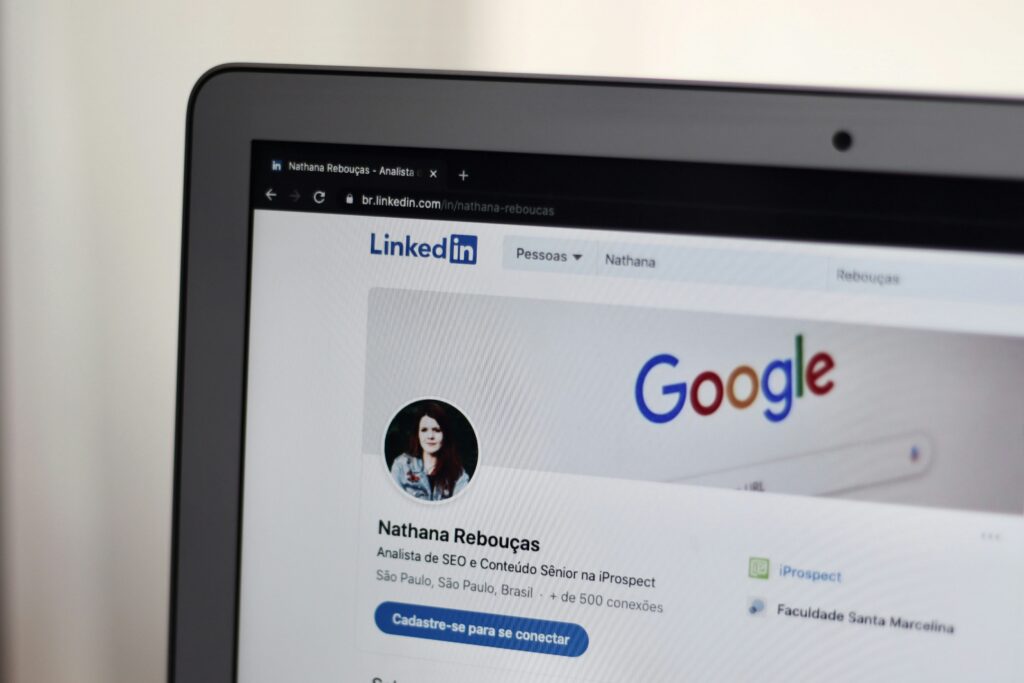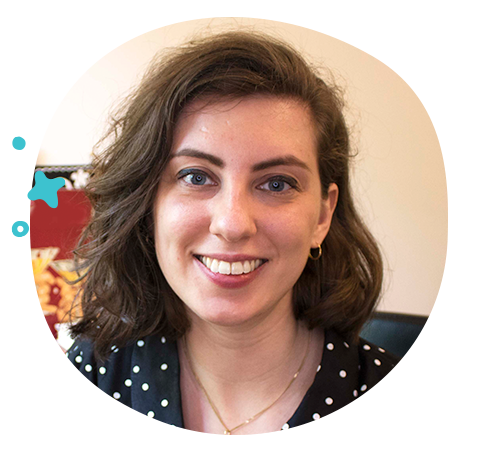Whether you prefer working on a freelance or commission basis or license your work to companies, at one point or another you’ll have to expand your client base.
Finding new clients and opportunities as a surface designer or illustrator is a big task, but can be done by staying organized and doing deliberate outreach. Here are some tips to help you navigate this journey effectively.

1. Identify and Pitch to Potential Partners
First, research brands that use surface designs, such as fashion, home decor, stationery, and textiles. Look at the products they offer and see if your work and design aesthetic would fit their style. Think of ways you could apply your style to what they might need.
Use Google and LinkedIn to identify what companies are looking for and how you can contact them. Find the art directors’ contact details or the company’s submission form. It can be tempting to reach out to the big companies right away, but keep in mind that there are many smaller companies you could be reaching out to. They might be interested in more specific and niche designs, and can be easier to pitch to.
Next up is approaching the company with your pitch. You’ll want to keep it brief and share your best and most relevant work with this company. Art directors who are looking for licensing or commission opportunities often only scan emails briefly, so share what you’ve got to offer in a few sentences.
Make it clear that you’re reliable and flexible, that you’ve got problem-solving skills, and understand strict deadlines. Share a few portfolio designs to show you’ve got the required skills and that your work aligns with their brand. Use the research you’ve done to personalize your message and portfolio.

Don’t try to cover all the categories: All this outreach can take up a lot of time, especially as a new surface designer. There are many categories you could reach out to for licensing opportunities: home decor, stationery, gifts, paper, baby products, et cetera. Your designs, style, and what you have to offer might not work in every single product category. Instead, figure out what your designs might be best suited for, and focus on a limited number of categories. This will help you move forward faster, make your portfolio more personalized, and make outreach easier.
Related Article: Surface Design Branding: How to Stand Out in a Crowded Industry
2. Follow Up
You’ve done the hard work of making art, researching companies, and sending out pitches. So if you don’t get any responses immediately, it might be disappointing. But don’t give up just yet. Just because they’re not interested right now, doesn’t mean they won’t be later on.
Following up reminds them you’re actively taking on new projects. Even if you don’t have a lot of new artwork to share, showing up demonstrates to the art director you are consistent. Keep a list of names you can reach out to, and set a regular reminder for yourself to send out emails.
Additionally, you can send out updates to art directors through an email list. This way, you can reach out to more people with new artwork at once.
3. Keeping Things Up to Date
Even though you might be sharing your work in pitch emails, keep your social media, website, or online portfolio up to date. This is the best place to share a bit more of your work in detail, your process, and behind the scenes material. You could include a case study that explains a project from beginning to end; this is an opportunity to share your problem-solving skills and flexibility.
Make it immediately clear who your target client is, who you want to work for, and what you do. Don’t be afraid to share that you’re open to taking on new clients where you can. An impressive online presence also means an art director can find you, instead of having to reach out to companies yourself continuously!

Additionally, make sure your portfolio highlights designs that are ready for licensing in collections. This shows a potential partner better what you could do for them. They can then pick ideas from your portfolio and adapt them to their products. You could organize your work in themes or small collections to make it easy for a client to see what might fit their products.
Lastly, don’t forget to show off your artwork in detail to stand out from the crowd. A zoomed-out overview is essential, but sharing the small details of your artwork lets an art director know what you can do artistically, and shows off your attention to detail.
It allows potential clients to take a closer look to see textures, lettering skills, and tiny features that otherwise might’ve been overlooked.
4. Mockups to Impress
A well-presented portfolio might seem obvious but it’s so important, as it’s the only result a potential client will focus on, so it needs to speak for itself. Adding mockups of your designs to your portfolio is useful for numerous reasons: it helps you and your potential client visualize what your art might look like on a product; and a mockup can showcase the look and feel of your design in an instant.
It also shows you are actively thinking about what the client might need and are designing with the final product in mind. Furthermore, it is made clear immediately what sort of products or themes you want to work on.
If you want to work on baby and toddler products, display your designs in a nursery, for example. You can simply create digital mockups, or print, set up, and photograph your own designs if you want a more custom look.

5. Stay Informed and Adapt
Keep up with trends and industry news, so you can make changes to your portfolio if necessary. There might be a shift in consumer preferences that you’ll want to adapt to. You don’t have to change up your entire portfolio; perhaps changing a color palette slightly might simply attract more potential licensors at that moment.
When you’re creating new work, try to incorporate some industry trends you found while researching to attract contemporary clients (while staying true to your preferences, of course!).
You can also stay up to date by joining associations in the industry. These organizations can help you find potential clients, find support, network with other surface designers, and stay up to date on changes in the industry. You can attend events like trade shows, art fairs, and industry conferences to meet potential clients and collaborators too.
6. Feedback
If you’re just starting as a surface pattern designer, or are just not sure where to start with your portfolio, ask for help. It’s easy to work in a vacuum as a freelance designer, so it’s important to seek feedback from different perspectives so that you understand the surface pattern design markets.
You can talk to a fellow designer and ask what you could improve. You could also seek feedback from industry professionals to continually improve your designs and approach. This could be an art rep, mentor, et cetera. They’ll understand the industry best and know how you can make your designs more attractive to art buyers and art directors.
Professionals in the industry will also help you make your portfolio as marketable as possible; they work with a lot of other surface designers and know what companies are looking for, and how this can be best represented in your work too. Keep in mind to trust your creative instincts and have confidence in your abilities, but always stay open to learning and constructive criticism.
7. When To Say No
Once you do find a potential client to work with, keep in mind who you want to say yes to. Saying yes to something could potentially mean having to say no to something else because you don’t have the time or resources.
Being stuck in a period of less work and increased desperation might make you want to say yes, even if it’s not the right client for you. Additionally, a really big client would make you want to say yes, without considering the actual practicalities.

When deciding on taking on a new client, here are a few things you can keep in mind:
- Ideally, the client project is challenging and helps you to grow in the right direction. Not every opportunity needs to feel that way, but make sure you take on a few projects that you feel proud to put in your portfolio, and that you can use as examples when you reach out to new clients.
- The communication needs to work. Especially when working with a client on a freelance or commission basis, work will involve a lot of negotiation and brainstorming. It’ll be a lot nicer to do this with someone who you feel supported by. A lot of things will only become clear once you start working with a client, but look out for the initial phase of communication and judge if this client will be right to work with.
- This opportunity should work for you financially. Taking on higher-paid work sometimes could be not exactly what you want to do, but will allow you to do lower-paid work that is more fulfilling. Find a balance that works for you and don’t forget to charge your worth.
Refer to a list of points that are important to you when making decisions on projects; this is a good way to check in with your values. Especially when you’re in a starting phase, it’s okay to say yes to everything, but ultimately, keep your goals in mind and don’t undersell yourself!
8. Relationships Take Time
Building a relationship with a new client takes time, so don’t give up when pitching didn’t work out the first time around (remember the follow-ups!). The skills a lot of clients are looking for like trust and reliability, are simply not easily shown in just one email.
Just because they haven’t gotten back to you now, doesn’t mean they won’t in the future. Often, art directors keep a list of artists and designers on hand, so that when the time is right for a particular project or product, they can be contacted then.
When reaching out and finding new clients, stay open-minded and flexible about the opportunities that come your way, too. Your journey may not always follow a linear path, but each new opportunity can contribute to your growth and development.
By leveraging your illustration skills, networking within the industry, continuously learning, and staying open to opportunities, you can successfully build up your client base and thrive as a surface designer. Finding and securing lucrative licensing opportunities as a surface designer takes time, so be patient, keep creating art, and follow up!

Written by Claire van Kuijck
Website: clairemakesthings.es
Instagram: @claire.makesthings
Claire, of Claire Makes Things, is an illustrator and teacher from the Netherlands, based in Madrid, Spain. She creates murals, chalkboard designs, greeting card designs and more, and teaches illustration and graphic design. She loves all things retro, cocktails, and riding her motorbike.